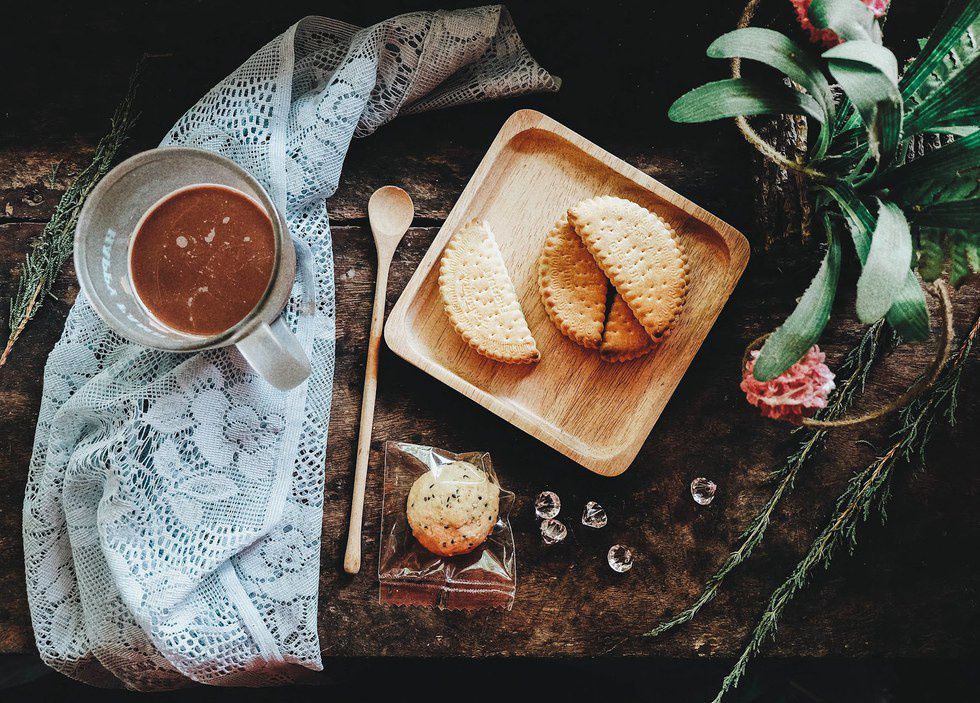Hygge (HOO-gah): Danish. To create a warm environment. Intentional, deliberate space-making. Ritualistic well-being. Often in reference to simple, everyday activities.
Every few months the internet hands us a new buzzword to distract from the meaninglessness of existence our busy lives. 2016 introduced us to “Brexit,” a few years prior we put language to “the millennial generation.” Right now, it’s hygge or “coziness.”
Hygge is a concept… a lifestyle, if you will… that plays nicely with bloggers and hip adults. Hygge is the feeling you get when things are just right. For example, I am at optimum hygge perched atop my best friend’s mattress, wearing a giant pair of socks, chatting about traveling new places. My hygge is also a jazz club, a late breakfast, or cozying up with a hot coffee and Law & Order.
And candles. There are always candles in hygge.
Hygge is about our perceptions, our environment, and our feeling state.
It’s very likely the hygge fad will fade, and next year we will have a new lifestyle to aspire to (am I sounding blasé today? I apologize, it’s the weather). But newly sober folks would be wise to take a few notes from hygge… Hygge has a lot to do with self-care, and self-care is vital in our transition from treatment to sober life. Probably more that you assume.
It’s late January here in Michigan. The holidays are over, the magic and anticipation is over. And although we’ve had a pretty temperate month, the listlessness in the air is undeniable. I adore Michigan… I adore it’s lakes, I adore it’s lush and vibrant autumns, but no amount of sailboats or apple cider can detract from a midwestern winter. We’re in the thick of it.
It’s cold here. And wet. Like, very wet. All of the time. Everything has a grime on it.
And it’s about now, post-Christmas and pre-spring, that SAD (seasonal affective disorder) creeps in unnoticed.
Further, the 2016/17 season has been taxing… exhausting… scary and upside-down for many people. A psychiatrist friend remarked on an unprecedented political anxiety… Clients pointing to the political climate as a source of significant feelings of crisis, unrest, and helplessness. Regardless of your affiliation, 2016/17 has presented a number of transitions. And transitions are stressful. (My advice, for what it’s worth, is to stay informed and stay off Facebook.)
All the more important, sober folks, to create (what our Nordic friends call) an “at-home haven.”
As an art therapist, aesthetics are important to me. From the time I was a little girl, people described me as “peculiarly particular…”
Don’t touch those flower petals! I spent all morning arranging them!
Did you borrow a CD? I ordered them by mood… It’s fine, I’ll redo it.
As I’m typing this, I’m looking at two empty sleeves of matches I have so carefully placed on a side table. To most people, it looks like I emptied my pockets and forgot about it. I spent 10 minutes finding a home for those matches.
WHY HYGGE in recovery?
Recovery is hard work. Recovery requires the recover-er to engage in (literally) hours of introspection, lectures about biology and brain chemistry, physical exercise. It’s structured. And it’s consistent.
Recovery also has its comforts. Sanford House prepares beautiful meals, transports to and from, keeps up on housekeeping. We schedule our curriculum in such a way that residents participate in full-time wellness activities, and are continually challenged to share their thoughts and feelings. Treatment centers provide near-constant care in an effort to encourage folks to become their best selves.
So returning home from treatment can feel chaotic. The demands of work, school, and family do little in the way of creating a space for self-care. And strain can lead to relapse. I hear from so many of my clients: “In treatment the mindset is all about me and that’s uncomfortable. I don’t know how to take care of myself.”
To plan for self-care is to plan for relapse prevention. You learned a number of strategies about how to focus on sober living, coping skills, aftercare during treatment… so practice them!
HOW HYGGE in recovery?
1. Hygge is your sanctuary amidst everyday life. A hygge space reflects coziness: a relaxing armchair, the kitchen table, a daydream of the ocean. Think: space, company, and intention.
2. Hygge (either at home, the office, or your mind’s eye) permits you to breathe. You may be encouraged to reflect on your choices throughout the day, name your gratitudes, or sit quietly.
3. When your headspace is clear, you are better able to process stimuli and dial into your emotional needs.
4. Self-care and “me time” are one way to respect yourself. Affirm your worth. These aren’t just buzzwords; you deserve to be taken care of.
After an art therapy session, clients are asked to take a moment and “Respect your image. You made that… that came from your mind and your hands. Pay yourself attention.” I get a lot of eye rolls, but I keep saying it.
5. Surround yourself with people and items that help you feel satisfied, calm, and safe. Reduce clutter. Reduce the number of items in your home in general (or simply in your hygge space).
6. Be gentle with yourself, and reward yourself for working hard in recovery today. Explore the balance of “me time” vs connection with others. Set boundaries and keep them.
7. Use your hygge space to strengthen your spiritual connection through meditation, intention-setting, artmaking, or prayer.
8. Go out of your way to indulge in healthy self-care.
9. Ground yourself in your hygge space, and simply exist in the present. See how long this feeling lasts. When and why did it disappear?
10. Remember to live consciously, act deliberately. Pay attention.
So in the midst of wintery sadness, of which the Danes know well, perhaps self-care and hygge can help keep you on track. Yes... hygge as both a trend and a coping strategy. Hygge as a mindfulness tool, as a reminder to create a life that feels less burdened and more worthwhile. Moving from boredom and apathy into joy.
And lest we forget, a major tenet in hygge is our connection with others. What would happen if we engaged in meaningful intimacy instead of haphazardness? How would our mood and attitude and outlook and anxiety-level change if we asked “What do I enjoy about life?” Instead of “How was I disappointed today?”







 The author, lounging hygge-style.
The author, lounging hygge-style.






















